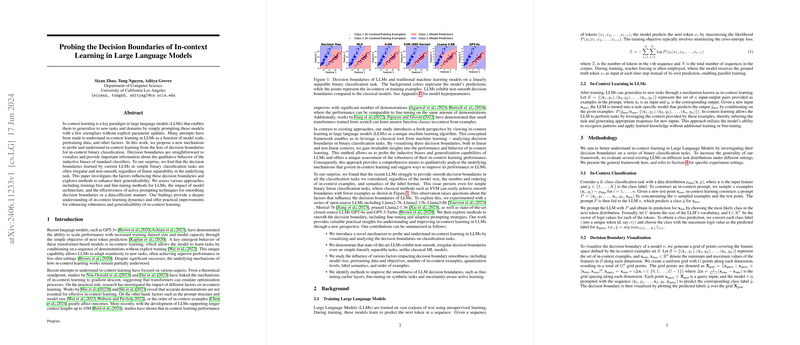Probing the Decision Boundaries of In-context Learning in LLMs
The paper "Probing the Decision Boundaries of In-context Learning in LLMs" by Zhao et al. explores the dynamics of in-context learning within LLMs. Specifically, the authors focus on understanding the irregular and non-smooth decision boundaries exhibited by LLMs during simple binary classification tasks. This investigation offers valuable insights and proposes methodologies to enhance the generalizability and robustness of in-context learning in these models.
Key Contributions and Methodology
- Novel Mechanism for Understanding In-context Learning: The paper introduces a unique perspective by examining the decision boundaries of LLMs in binary classification tasks. This approach allows the authors to visualize and analyze how LLMs react to in-context examples, providing insights into their inductive biases and generalization capabilities.
- Comparison with Classical Models: The paper highlights that LLMs, despite their advanced capabilities, exhibit non-smooth and irregular decision boundaries even on linearly separable tasks where traditional machine learning models such as SVMs and MLPs demonstrate smooth decision regions.
- Impact Analysis of Various Factors: The authors delve into several factors influencing the decision boundary smoothness of LLMs, including model size, pretraining data, number of in-context examples, quantization levels, label semantics, and the order of in-context examples. Surprisingly, increasing model size alone did not result in smoother decision boundaries, indicating that more complex interactions and learning dynamics are at play.
Significant Findings
- Non-Smooth Decision Boundaries: Across a range of LLMs, including GPT-4 and Llama series, the decision boundaries for binary classification tasks were found to be fragmented and non-smooth. This is an intriguing finding given that these models achieve high test accuracy, yet their underlying decision-making processes appear inconsistent and unreliable.
- Quantization Effects: The paper reveals that lower precision quantizations, such as 4-bit quantization, significantly distort the decision boundaries, particularly in regions where the model is most uncertain. This suggests that quantization can adversely affect the model’s reliability in sensitive decision contexts.
- Sensitivity to Prompt Formats and Example Orders: LLMs displayed varying decision boundaries depending on the prompt structure and the order of in-context examples. This sensitivity underscores the importance of considering contextual and sequential factors when deploying LLMs for in-context learning tasks.
Practical Implications
The findings have several practical implications:
- Deployment Strategies: When deploying LLMs for real-world applications involving in-context learning, it is critical to account for their sensitivity to prompt formats and example orders. Strategies to ensure robustness against these variables need to be developed.
- Optimization Techniques: The paper identified methods such as fine-tuning earlier layers and employing uncertainty-aware active learning to enhance decision boundary smoothness. These techniques could be integrated into the training protocols of LLMs to improve their reliability and performance.
Future Directions
The research opens multiple avenues for future exploration:
- Generalization to Multi-class and Complex Tasks: Extending the current findings to more complex and multi-class classification tasks would validate the generalizability of the proposed methods.
- Enhanced Fine-Tuning Approaches: Further refinement of fine-tuning strategies, potentially incorporating advanced meta-learning techniques, could lead to better in-context learning performance.
- Integration with Closed-Source LLMs: Developing techniques that can be applied within the constraints of closed-source LLM environments will be crucial for broader applicability.
In conclusion, Zhao et al.'s work offers a structured approach to probing and understanding the decision boundaries of in-context learning in LLMs. The insights garnered highlight critical areas for improvement and lay down a pathway for enhancing the robustness and generalizability of these models in practical applications. This research forms a foundational step towards achieving more reliable and interpretable in-context learning within the expanding domain of LLMs.
